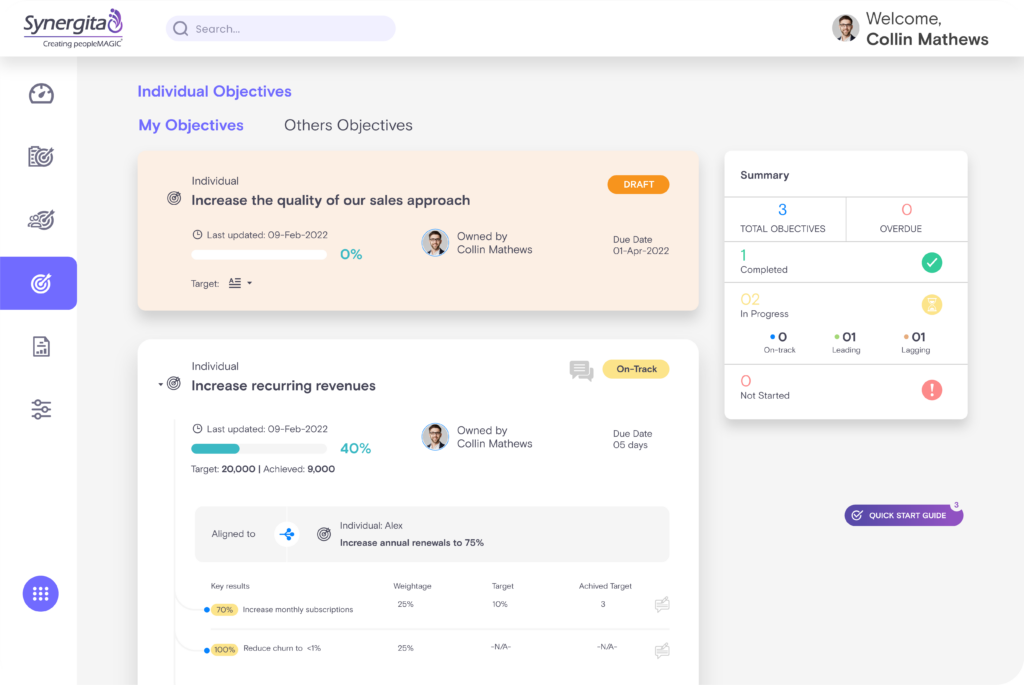Buyers Guide on OKR
OKRs have been gaining popularity as a tool for setting and measuring progress and success in organizations, but what exactly is an OKR, and how can you go about setting up your own? This Buyers guide will help you with everything you need to know about OKRs to enable better decision-making.
What are OKRs?
An OKR is a performance management system that provides a framework for setting measurable goals and tracking progress.
The key benefits of using an OKR system are that it can help to:
- Simplify and clarify the goal-setting process.
- Help track the progress and identify areas of improvement.
- Encourage and motivate employees to achieve results.
- Facilitate better communication between managers and employees.
Origins of OKRs
The origins of OKRs can be traced back to the 1970s. A young engineer named Andy Grove was working at Intel, and he came up with the idea of using measurable goals to manage his team’s performance. He called these goals “objectives and key results,” quickly becoming popular within the company. Since then, OKRs have been adopted by many other businesses, including some of the world’s largest companies. Google is perhaps the most famous example; they’ve been using OKRs since the early 2000s, and they credit them with helping them achieve their incredible growth.
If you’re thinking of implementing OKRs in your own business, there are a few things you should keep in mind:
- Your objectives must be specific, measurable, achievable, relevant, and time-bound.
- Everyone on the team must understand the objectives and how they fit into the larger picture.
- Adjust your objectives as needed; even the best-laid plans can change over time.
What are the benefits of using OKRs?

There are many benefits to using OKRs, but some of the most notable ones include the following:
- Increased clarity and focus.
- Improved communication and alignment.
- Increased accountability.
- Track progress and identify areas of improvement.
You should be able to set goals and track your team’s success by aligning their efforts with your business goals. You can promote consensus and innovation by collaborating with all of your employees. This enables your employees to align with your enterprise’s vision and achieve tremendous business success.
OKRs help you think about what you want to achieve with your objectives and how you will measure progress towards those objectives with your key results.
One of the most important things to keep in mind when setting up your OKRs is they should be aligned with your organization’s overall strategy. In other words, your OKRs should support achieving your company’s mission and vision. The mission and vision of the enterprise play a significant role in determining what your OKRs should be. Your company’s mission should answer the question, “Why do we exist?” while your vision should answer the question, “What is it we want to achieve?” Once you understand your company’s mission and vision, you’ll be better positioned to set meaningful goals.
Then, it’s time to start identifying your priorities. What are the most important things you need to achieve to support your company’s mission and vision? These are the things that should be at the top of the list.
Another critical thing to remember is that OKRs should be ambitious yet achievable. You don’t want to set easy-to-achieve goals that they’re not worth pursuing, but you also don’t want to set impossible-to-reach goals. The sweet spot lies somewhere in the middle.
There are a few common mistakes that people make when setting up OKRs. The most common being:
- Not being clear on what the objectives are. They should be specific, measurable, attainable, relevant, and time-bound.
- Not involving all the relevant stakeholders in the process. It’s crucial to get buy-in from all the relevant parties before setting OKRs.
- Not setting realistic goals. The objectives should be challenging but achievable. Setting unrealistic goals will lead to frustration and disappointment.
- Trying to do too much at once. Focus on a few key objectives is essential. Try not to tackle too many things at once. Otherwise, you may feel too overwhelmed and end up without much progress.
- Not reviewing and adjusting the objectives regularly. The objectives should be checked periodically to ensure they are still relevant and achievable. If they need to be adjusted, don’t be afraid to do so.

Conclusion
If you’re looking to implement OKRs in your business, this buyer’s guide will give you all the information you need to get started. OKRs can be adapted to any size organization and any industry, so there’s no excuse not to give them a try. With our tips, you’ll be able to set up your own OKRs with ease and start seeing results in no time.

